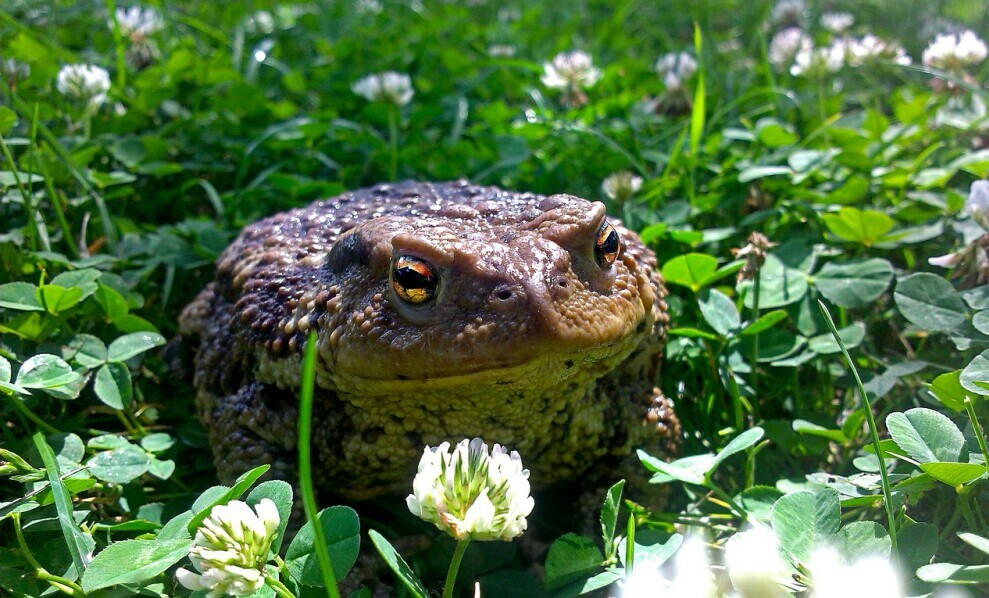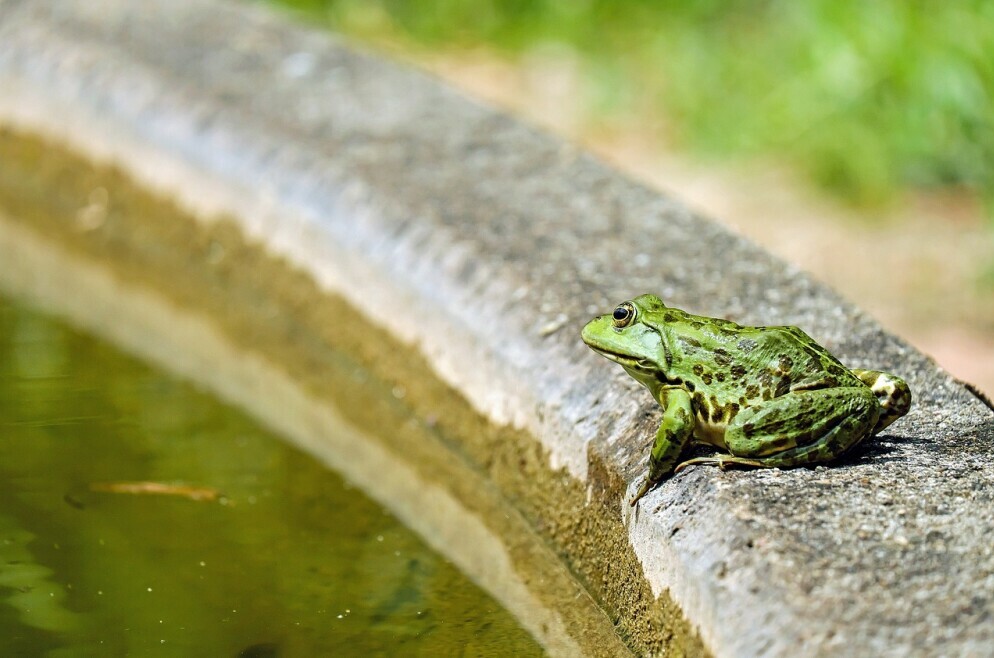Have you considered creating frog-friendly gardens to support your local species? Most people don’t think of frogs and toads in their gardens but there are reasons why you should.
These cute amphibians are some of the best Ecosystem Helpers we have. Frogs and toads are like nature’s pest control squad. They gobble up insects—mosquitoes, flies, and other bothersome critters—that could otherwise wreak havoc on our gardens and forests. So, next time you’re enjoying a warm summer evening, listen closely—you’re probably hearing their melodious calls while they’re busy feasting on bugs!

We love watching our garden grow. But a garden buzzing with life isn’t just a treat for the eyes; it’s a sign of a healthy ecosystem. Frogs, with their wide array of species, play a pivotal role here. They’re not only intriguing creatures but also essential eco-warriors, partaking in pest control and indicating environmental health through their presence and abundance.
You’re going to find out about the grim realities these critters face: their habitats are shrinking fast due to human encroachment, pollution is marring their breeding grounds, diseases like chytridiomycosis are wreaking havoc, and the changing climate throws yet another curveball into their survival. This bleak picture deserves our attention because the decline of frog populations can upset the delicate balance of nature, affecting other species, including us.
But this isn’t just about doom and gloom; it’s also about hope and action. By transforming your green space into a frog-friendly habitat, you contribute to local wildlife conservation and step into the role of an environmental steward right in your backyard. Your efforts support these vital creatures and thus the broader ecosystem.
So, on to the nitty-gritty: how do you create such a sanctuary? The next section, ‘Designing a Haven: Key Elements of a Frog-Friendly Garden,’ will lay out the essential features your garden needs to roll out the welcome mat for frogs. Prepare to explore the importance of location, water features, and the right foliage to make your garden a hoppy place for these incredible amphibians.
Designing a Haven: Key Elements of a Frog-Friendly garden
You’re going to find out about what makes a garden a perfect spot for frogs to call home. Creating an amphibian-friendly environment isn’t just about aesthetics; it’s about understanding and catering to the specific needs of these creatures.
First up, location matters. Your garden should ideally be near natural bodies of water or wetland areas. This proximity supports the lifecycle of frogs and helps maintain ecological connectivity.
Water features are, not surprisingly, a centerpiece for any frog haven. You’re going to want to include a pond or create a wetland area in your garden that doesn’t dry out and is safe from predators. A shallow sloping edge allows frogs to easily access and exit the water.
Native plants play a vital role. Choose varieties that thrive in your local climate and can provide shelter, breeding sites, and a bonanza of insects for frogs to feast on. Think also about layering—the combination of shrubs, ground covers, and trees to mimic natural habitats.
Remember to avoid using harmful chemicals and pesticides. These can be detrimental, not only to frogs but also to the entire ecosystem your garden supports.

Water Wise: Creating a Sustainable Aquatic Environment
Don’t worry too much about creating a perfect pond right off the bat. Your first try at making a frog-friendly water feature will evolve over time. The key is to ensure you have clean water and avoid introducing any chemicals that could harm the frogs.
Clean, chemical-free water is crucial for frogs as they absorb substances through their skin. This makes them vulnerable to pollutants and toxins in the environment. Don’t use pesticides or synthetic fertilizers near the pond, as they can wash into the water and affect the frogs.
A balanced aquatic environment includes a diversity of plants and animals. Algae, when controlled, can be part of a healthy pond system. But an overabundance can deplete oxygen and harm frogs. Consider adding aquatic plants that compete with algae and provide oxygen.
Pond maintenance is a necessary part of having a water feature in your garden. Think about pond depth, as shallower areas warm up faster and can be beneficial for tadpole development. Regularly clean any debris and consider a gentle aeration system to keep water circulating.
In terms of seasonal care, your pond needs different attention as the seasons change. For example, during autumn, you might need to net the pond to keep falling leaves out, while in spring, you can introduce more plants that will flourish and provide habitat through the summer.
The Land Connection: Integrating Your Garden with Local Landscapes
You might think your garden is a world of its own, but it’s actually part of a bigger picture. Integrating your frog-friendly garden with local landscapes is about creating a seamless transition from your personal oasis to the wild areas beyond. This isn’t just about aesthetics; it’s about forming ecological corridors that allow frogs and other wildlife to move freely and safely across different habitats.
To start, consider your garden’s place in the broader landscape. Look for natural features like streams, woods, or fields nearby. By aligning your garden’s design with these elements, you’re bolstering the continuity of the natural habitats. Think of it as extending an invitation to critters beyond your backyard. Mimicking these natural landscapes can provide the link needed to bridge isolated habitats, which is vital for species with small ranges and those that migrate seasonally.
But don’t stop at design – dig into the dirt with sustainable, organic gardening practices. This means saying no to synthetic pesticides and fertilizers that can be harmful to frogs, whose permeable skin makes them particularly susceptible to contaminants. Instead, engage with organic alternatives that enrich the soil and maintain a balance without the harsh side effects. Your froggy friends and the environment will thank you.
Biodiversity is your garden’s best friend. By attracting a variety of creatures – from insects and birds to small mammals – you’re not only providing a buffet for your amphibious guests but also building a robust ecosystem that can resist disease and pests naturally. That’s going to include establishing a wealth of native plant species that cater to the needs of different wildlife, as well as finding a harmonious balance among those living within your garden.
Your efforts in creating this land connection do more than just foster a habitat for frogs. They also help other local wildlife, which is crucial given the increasing threats to natural spaces. It’s like throwing a stone into a pond – the ripples of your actions spread far and wide, influencing the local ecosystem in positive ways. Now, let’s take the leap from the land to your own backyard by inviting those frogs over. Next, you’re going to find out about the inviting tactics that’ll transform your garden into a hub of amphibian activity.
Build It and They Will Come: Attracting Frogs to Your Garden
Creating a sanctuary for frogs isn’t just about aesthetics; it’s a meaningful endeavor to support local ecosystems. I’m going to share with you ways to make your garden an irresistible stopover for these hopping friends.
First off, focus on the trifecta of frog comfort: warmth, moisture, and cover. Frogs love damp environments, so keep your garden’s water features topped up and think about installing misters if you’re in a drier climate. They also need shady spots to escape the heat, so incorporate plants that provide ample canopy or consider adding a small log or rock pile for them to hide under.
Now, when it comes to actual frog tenants, it’s best to let them come naturally rather than introducing them. Why? Because local frogs are already suited to your area and bringing in outsiders could disturb the delicate balance. Plus, it’s just plain cool to see who shows up on their own.
If you really want to play cupid for your local frogs, why not have a chat with a local wildlife expert or a conservation group? They can give you tips specific to your area’s native species. Remember, you’re setting the stage for nature to take the reins—so patience is key.
Okay, let’s say the frogs have found your garden’s vibe appealing and they’ve moved in. You might be wondering, ‘What’s next?’. Well, that’s going to include making sure their new home stays inviting season after season, which is exactly what I’ll be talking about in the next section. Keep up the good work, and before you know it, you’re going to find out about maintaining the perfect frog-friendly garden all year round.
Maintaining an Eco-Oasis: Best Practices for Garden Upkeep
I’m going to walk you through the essential best practices for keeping your frog-friendly garden thriving. Don’t worry too much about getting everything perfect from the start; you can always tweak your methods down the road.
When it comes to pest control, it’s tempting to reach for chemical solutions, but in my opinion, that can do more harm than good. Instead, opt for natural predators like birds and beneficial insects. Establishing a balanced ecosystem isn’t just about protecting frogs; it’s also about letting nature manage itself.
As seasons change, your garden will need different kinds of care. Preparing for winter might mean adding extra mulch for insulation, and summer care could involve providing additional shade or water sources.
In terms of a long-term strategy, think about this: your garden is part of a larger ecosystem. So, the choices you make, such as rotating crops or adding native species, can have a profound impact on local wildlife and the health of your garden residents.
Measuring Success: The Impact of Your Frog-Friendly Garden
You’re about to discover just how impactful your efforts can be. Creating a frog-friendly garden doesn’t just provide a sanctuary for these charming amphibians; it also contributes to the broader health of the ecosystem. To gauge the success of your endeavors, take note of the variety and numbers of frogs and other wildlife that begin to inhabit your garden space.
Active participation in local wildlife research can magnify the positive effects of your garden. By sharing observations and data with conservation groups, you become part of a larger effort to protect and understand frog populations. This not only aids in scientific research but also helps in fine-tuning conservation strategies to be more effective.
It isn’t just about fostering a healthy environment for frogs, though—it’s also about enhancing your own life. A bio-diverse garden can serve as an invaluable educational tool for children and adults alike, demonstrating the interconnectivity of nature. Moreover, it’s incredibly rewarding to see a living ecosystem thrive because of your dedication. Knowing you’re making a difference can be profoundly satisfying.
Let’s not forget the sense of community that can blossom from these initiatives. I’ve found that frog-friendly gardens often spark curiosity and interest among neighbors, potentially inspiring a chain reaction of conservation efforts throughout your community. Together, you can create a mosaic of habitats that support both local and migratory species.
In conclusion, the ripple effect of your work transcends your garden’s boundaries. It enhances biodiversity, supports environmental education, and fosters community spirit. Remember, every frog that finds a home in your garden represents a small victory for conservation. So, take pride in the oasis you’ve built and watch as it becomes a cornerstone in the quest to sustain and celebrate the natural world.
